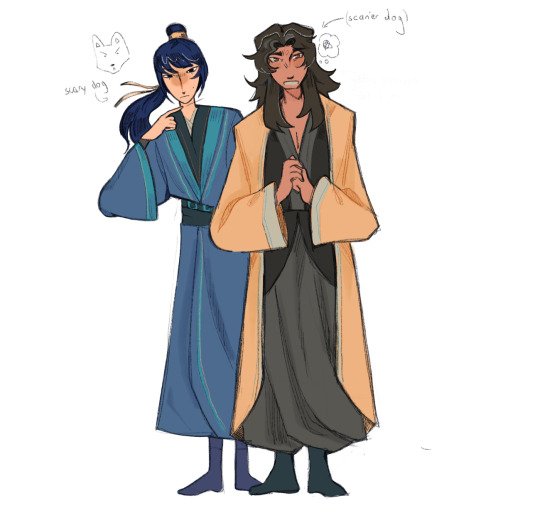Text
Rereading dvawtk and omg WRE. He reads a description of a young girl falling in love and immediately assumes that she got struck by literal lightning, and the lightning fried her brains and that's why she spends all her time acting like a love struck idiot illogically
87 notes
·
View notes
Text

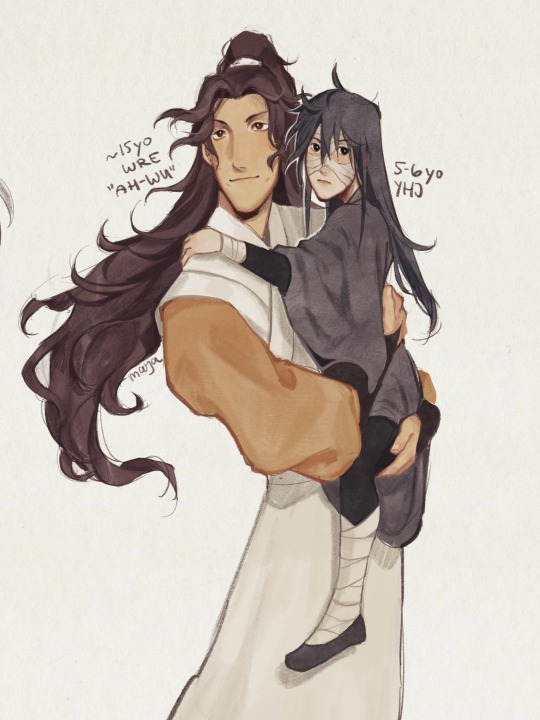
my headcannon designs for young wre and yhj (second soul communion truthers, rejoice!)
104 notes
·
View notes
Text
Devil Venerable Also Wants to Know as Reductress Headlines:
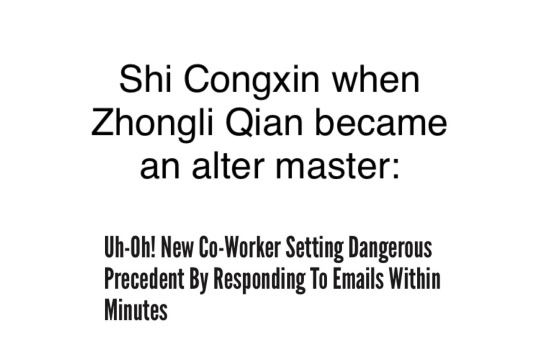







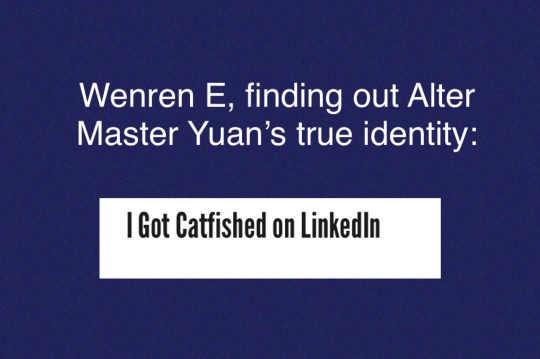
Dvawtk memes: Part 2 Part 3 Part 4 Part 5
195 notes
·
View notes
Text
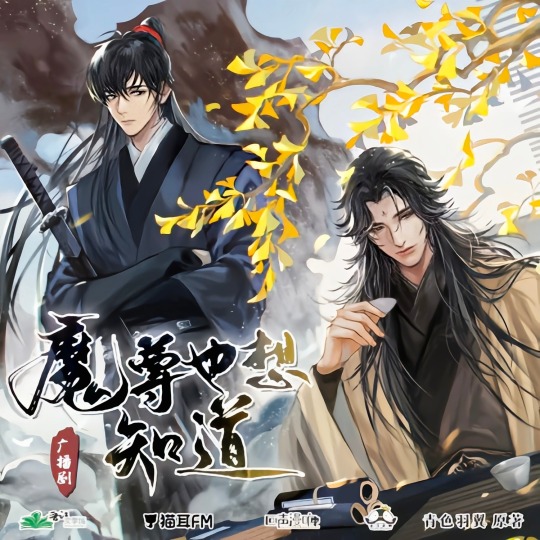




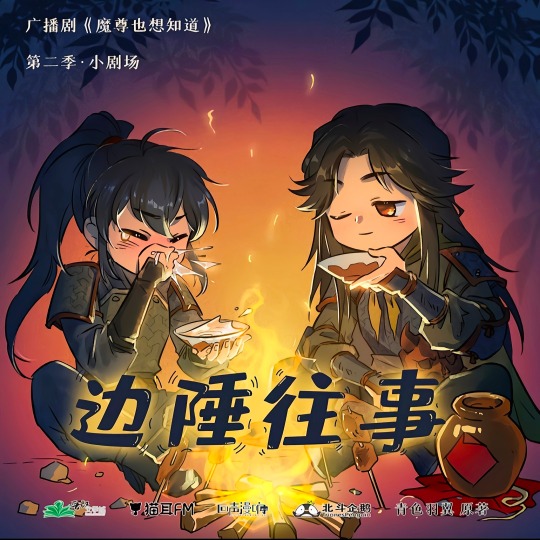


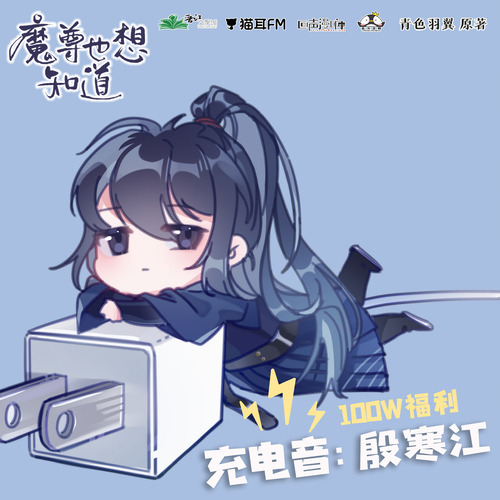

Wenren E and Yin Hanjiang official arts from the Audio Drama adaptation of Mozun Ye Xiang Zhidao (The Devil Venerable Also Wants To Know)
120 notes
·
View notes
Text
noticing the lawful evil of the xuanyuan sect:
shu yanyan says she always gets sexual consent for her cultivation partners who she plans to drain dry of their spiritual energy
qiu congxue recommends baili qingmiao murder the man she loves, puts a mark on his soul so she kind find him after he reincarnates, and then wait till he's 18 to romance him again
150 notes
·
View notes
Text

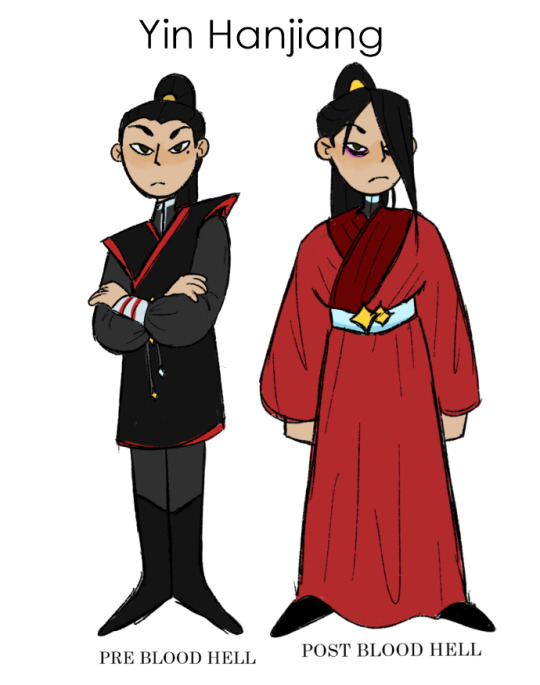
Some chibi adjacent style cast pictures for the lads in Devil Venerable! If I knew how to make stickers, I'd love to make some like these lmao. I've got some more I may post tomorrow as well.
Anyways if your into Devil Venerable perhaps join our new little discord server here
202 notes
·
View notes
Text

Devil Venerable Also Wants To Know main characters as the jealous man meme.
I love this story so much, I think it is my favourite danmei story I've read so far.
This took so so so much longer than I'd expected, not only due to anxiety brain and overthinking but also because I got very very sick on top of it all.
Drawn entirely in Krita.
229 notes
·
View notes
Text
Exposing SVSSS Fanon: 22/∞
LUO BINGHE AND SHEN QINGQIU WERE MEANT TO END UP TOGETHER IN THE ORIGINAL DRAFT OF PIDW
Rating: FANON - CONFLICTING
There is a somewhat common interpretation in fandom that in Airplane's original outline for PIDW, Luo Binghe and Shen Qingqiu were meant to be together in the end. While this could be an entertaining concept, and there is a potential argument to support it, I believe that this interpretation conflicts with canon due to the fact that a contradictory intention for the original draft was directly stated.
The original idea most likely comes from the following quote:
Shang Qinghua raised his arms high. “Cucumber-bro,” he said, impassioned, “if the System hadn’t selected you, a loyal and die-hard reader, I’m afraid the plot would never have been distorted to this extent, right back to the outline I discarded..."
(7 Seas, Ch. 21)
While it is certainly one possible interpretation to read this as "the plot of SVSSS is what Airplane would have written," and on first glance it does appear to be this way, I think that this has much more to do with the type of characters and the filling of plot holes, as earlier in the conversation, he says this:
"...Compared to writing the kind of stallion guy who’s everywhere on Zhongdian, it’s better to portray a male lead like the current Bing-ge, whose life is full of mishaps, whose personality is a bit more complex and full of contradictions and conflicts—that kind of weirdo. That’s more in line with my writing philosophy.”
(7 Seas, Ch. 21)
Shen Qingqiu is the one who first remarks on sexuality, and Airplane defends gay protagonists, but the "original outline" seems to be more likely referencing this quote.
There is also the interesting fact of this thought:
Why did that make it sound like the System and this world were the creation of Shang Qinghua’s regrets, as an author who’d had to scrap his outline in favor of popular opinion?
(7 Seas, Ch. 21)
Though this is just a side thought from Shen Qingqiu, it is an interesting thing to note nonetheless, especially if one also considers the system's original requirements:
【 One, change the nonsensical plot and raise the average IQ of the villains and supporting characters. Two, avoid landmines that break suspension of disbelief. Three, ensure the main character’s satisfaction points. Four, discover and finish hidden plot events. 】
(7 Seas, Ch. 1)
If we follow the thread of "the system as a creation of Shang Qinghua's regrets," we can pair that with the list of requirements above. Of course, that implies that there is anything specifically to read from that earlier comment of Shen Qingqiu's, which may or may not be the case.
Considering the requirements, though, the only one that specifically relates to BingQiu getting together would be "ensure the main character's satisfaction points," but it does not specify romance between those two characters as the only way to do so.
While the first passage is the one mainly used to argue for this theory, one could also use the matter of Shen Qingqiu's red thread linking to Luo Binghe to support it-- that is, if one ascribes the cut thread to either Shen Yuan's former life, or to some other party, and the current thread belonging to the identity of Shen Qingqiu (not specifically Shen Yuan, therefore meaning that it was still present with Shen Jiu). This is a fairly weak argument, but one I will still address for clarity's sake. The text specifically says the following regarding the red threads:
“Sir, about the red thread from your past—my skill is insufficient, so I can’t…see it clearly. At first glance, it seemed like you were alone, but if I look carefully, I can catch a faint glimpse of another thread.” She concluded regretfully, “This thread has been cut… Such a pity.”
Shen Jiu had once had a fiancée, but Shen Yuan was a single dog! Their two threads were tangled together, so it was no surprise that the madam couldn’t see it all clearly.
(7 Seas, Ch. 23)
Shen Yuan assumes the cut thread belongs to Shen Jiu-- and this makes sense, since it is only a faint glimpse. The remnant of Shen Jiu's red thread remaining attached to Shen Qingqiu's body falls in line with the way that Shen Jiu's memories also remained to some degree-- even though it is Shen Yuan's soul which now occupies the body, there are still traces of its former inhabitant. As to who Shen Jiu's cut thread belongs to, that is a topic for another post-- nonetheless, it is safe to believe that neither of these threads of the past point to Luo Binghe. Notably, there is not one single red thread that stretches from the past to the future. The options in the past are either "alone" or "severed thread," regardless of whose is whose.
Of course, despite these arguments having strengths and weaknesses, nothing thus far has proven one way or another whether Shen Qingqiu and Luo Binghe were intended to be together-- for that, we must go to Shang Qinghua's own thoughts and the following passage:
【 Basic completion of Proud Immortal Demon Way’s original outline achieved (slight deviation in romance plotline); objective complete. Retrieving function to return to original world; download complete. Activate Return Home sequence? 】
Basic completion of the original outline? That he agreed with. All the holes that needed to be filled had been filled. But this “slight deviation of romance plot” wasn’t quite right. Bing-ge was now fully gay; how could you say that was a “slight deviation”? Ah, fine, fine, in fact, in his original outline, Bing-ge hadn’t even had a romance plotline; he had been doomed to fade away, alone and unaging forever. If you insisted on adding a romance plotline, all right, that was whatever, so putting aside all the System’s rambling…this meant he could return to his original world?!
(7 Seas, Ch. 26)
This passage makes it perfectly clear that the BingQiu romance was not part of the original outline, both in the system's note of "slight deviation in romance plotline," as well as in Shang Qinghua's own words-- that the original Bing-ge wasn't intended to have a romance at all.
If it were not for this section, I would rate the theory as unsupported or perhaps as neutral, but because there is direct clarification in the above passage, it can only be said that Luo Binghe and Shen Qingqiu were not canonically meant to end up together in the original draft of PIDW, and that this assertion is fanon which contradicts canon.
180 notes
·
View notes
Text
Exposing SVSSS Fanon: 14/∞
ALL DEMONS NATURALLY HAVE MARKS ON THEIR FOREHEADS
Rating: FANON - CONFLICTING
In SVSSS, heavenly demons like Luo Binghe, Tianlang-jun, and Zhuzhi-lang have a vermillion mark on their forehead. In fanworks, other demons such as Sha Hualing and Mobei-jun are also depicted as having such a mark.
This conflicts with canon, as the mark is exclusively a symbol of the Heavenly Demon Bloodline, rather than all demons:
“You are no simple demon,” Shen Qingqiu said. “That mark on your forehead is a mark of sin—the mark of the demons who fell from the heavens."
(7 Seas, Ch. 4)
I have often seen this mark referred to erroneously as "huadian (花钿, literally "flower ornamentation")." Though there are similarities in color and location between the two, huadian is a type of traditional-style makeup worn with hanfu, while the mark on a heavenly demon's forehead is 罪印 (Zuì yìn,literally "criminal seal" or "seal of guilt”), translated to english as "mark of sin."
It is a very specific, distinctive feature that heavenly demons have-- one that is most likely well-known to both demons and cultivators alike.
The mark of sin can be repressed, however it will reappear when angry:
For a split second, Luo Binghe’s expression was puzzled, causing his face to appear to soften, just a little. But soon this sliver of softness dissipated without a trace. His pupils contracted, and a red mark flickered at the center of his forehead in a burst of light.
(7 Seas, Ch. 10)
Or when weakened:
When he looked, though Luo Binghe’s eyes were closed, the heavenly demon mark of sin had appeared on his forehead, lines of crimson pulsing along with his breaths. The red glow flickered on and off along with it.
(7 Seas, Ch. 16)
Which suggests that it takes some amount of conscious effort to suppress and conceal.
Heavenly Demons (天魔,天之魔) are somewhat set apart from the demon race (魔族)as a whole, despite both being called demons. Heavenly Demons specifically did not originate within the demon world, but instead fell from the heavens:
Legend had it that these denizens of the heavens had fallen to depravity and become demons, so they were called “heavenly demons” for short.
(7 Seas, Ch. 2)
Falling to depravity here is the same as succumbing to heart demons (心魔), which aren't altogether easy to explain, but can be thought of as mental and spiritual instabilities resulting from negative emotions and obsessions. This is the same "Xin Mo" as the name of the sword.
In the Xianxia genre, anyone can "become a demon" in this way-- a similar (almost identical, since based on similar philosophies) trope in western fiction would be in Star Wars, where one "falls to the Dark Side."
Therefore, the mark of sin or zuiyin if you wish to use pinyin, is linked to the heart demons and corruption of the heavenly demons and their descendants.
This is evident from the first moment when the seal on Luo Binghe's bloodline is removed:
Once that stream of light touched Luo Binghe’s brow, it seeped into his skin, turning into a fiery red mark. Luo Binghe was lost to his bloodlust. He didn’t know why, only that his head ached like it was about to explode, and he nearly collapsed to his knees. His entire body roiled with a desire to inflict savage cruelty.
(7 Seas, Ch. 4)
This sudden bloodlust is a result of the unsealing of his demonic bloodline-- with the mark of sin appearing along with it.
The mark of sin does not have one fixed appearance, either:
When he tested Luo Binghe’s forehead with the back of his hand, it was still scalding hot, and the mark in the center of his forehead was growing even redder and brighter.
(7 Seas, Ch. 16)
This occurs after Luo Binghe has been injured and poisoned, and is unconscious. The change in the mark's appearance is likely due to his weakened state.
The most significant example of this, however, is at Maigu ridge, when Luo Binghe has been entirely overtaken by Xin Mo's (the sword and the internal) corruption:
The dark-red mark of sin crept over his forehead, expanding outward until marks covered the entirety of his snow-pale face, then continued spreading down his neck. Xin Mo had fallen beside them, and it seemed to respond to the marks on Luo Binghe’s body: it glowed and dimmed, its purple light and black miasma circulating endlessly.
(7 Seas, Ch. 21)
By the end of this, the marks extend all the way down his arms:
Luo Binghe’s arm around him slowly tightened. As his tears continued to flow, he suddenly noticed that the marks on his arm were rapidly receding.
(7 Seas, Ch. 21)
From this we can conclude that heavenly beings succumbed to their heart demons and fell from the heavens to become the heavenly demons. Their demonic power originated not from their species alone but from their heart demons, which their descendants inherited as their own source of demonic power which is why LBH suddenly was overcome with bloodlust when his bloodline was unsealed. The mark of sin appears as a curse to mark those who succumbed to heart demons and fell from the heavens, but it can be suppressed through self control (i.e. controlling those heart demons)while it will reappear when that self-control is compromised in some way. When Xin Mo preyed on LBH's fears and insecurities, it caused him to fall entirely under the control of his heart demons-- which lead to the mark of sin spreading over his entire body.
Now that the origins and nature of the mark of sin have been explained, it's easy to say that other demons will not have such a mark, since they are not from that same cursed bloodline.
Of course, does that mean that everyone who draws Sha Hualing and Mobei-jun with marks on their forehead is drawing them incorrectly?
No, not necessarily.
The only thing this tells us is that ordinary demons do not naturally have this mark, and it will not have the same features (such as glowing, spreading, responding to emotional state, etc.).
It is entirely possible and believable that demons, especially demon nobility, would paint or apply a mark to their foreheads as part of their fashion and a status symbol.
For an explanation of this, let's go back to the huadian. While the exact origins of huadian ornament and makeup are unknown, there is a folkloric origin story to it. In this origin story, a plum blossom was blown onto the forehead of a princess while she was out on a walk (or alternately, fell onto her face while she was taking a nap). Afterwards, she was unable to wash it off, but because it looked strikingly beautiful on the princess, it became a new popular fashion trend for women to apply flower ornamentation or makeup to their foreheads.
Something similar could have happened with demon culture.
Of course, the ancient heavenly demons from whose lineage Luo Binghe hailed were the most elegant and traditional of the demonic bloodlines—equivalent to the Demon Realm’s blue blood nobility.
(7 Seas, Ch. 6)
The heavenly demon bloodline is the most noble and high-ranked in the demon realm, with heavenly demons considered princes and princesses:
As the future princes of demonkind, their bloodline was first-class.
(7 Seas, Ch. 2)
Tianlang-Jun’s younger sister counted as something like the demon race’s princess.
(7 Seas, Ch. 12)
Therefore, it wouldn't be strange for other lineages of demon nobility to attempt to imitate their appearances-- this may have something to do with noble demons appearing more humanoid as well. It could also mean that a similar thing to the huadian origin story may have happened and demon nobility took up the fashion of wearing forehead ornamentation or makeup to denote their status, perhaps even having various specific marks to denote clans or individuals.
Of course while this is a possibility, it is not something that comes from canon itself and would still be a headcanon or fanon, so it should not be used in an argument for a canonical depiction of Sha Hualing and Mobei-jun with marks on their foreheads.
While a depiction of demons wearing marks on their foreheads is not necessarily without basis or explanation, the idea that they have these marks as a natural physical feature is canonically inaccurate.
One footnote: while heavenly demons do not originate within the demon realm, their bloodline would still be counted as part of the demon race-- this is evident in the fact that Zhuzhi-lang, also a mixed-bloodline heavenly demon (but half snake-race rather than half-human), has a bloodline more pure than Luo Binghe's and is able to suppress LBH's blood in SQQ's body (perhaps the fact that the demon race as a whole utilizing demonic qi instead of spiritual qi for cultivation is what creates the divide). Zhuzhi-lang is still considered mixed-heritage, though, so it is unknown where the boundaries within the demon race itself lie. It is also possible that there is an entire untold story about the origins of the demon race which would change up various arguments here, but we don't have that origin story, and therefore there is no context aside from what's in the novel-- we can only assume that demons originated within the demon realm, while heavenly demons entered it later after falling from the heavens-- but they are still considered part of the demon race despite a different origin.
325 notes
·
View notes
Text
Exposing SVSSS Fanon: 8/∞
LUO BINGHE RECEIVED BOTH OF THE SCARS ON HIS BODY IN THE ABYSS SCENE
Rating: FANON - CONFLICTING
Luo Binghe in SVSSS has two scars on his body. The following passage clarifies both scars, and how and when they were obtained:
Luo Binghe instantly clutched that hand of his. Shen Qingqiu felt that the skin on Luo Binghe’s palm, which was pressing into the back of his hand, was uneven. When he looked closer, he realized it was a sword scar.
At first, Shen Qingqiu didn’t understand why there were so many scars on Luo Binghe’s body, but then he suddenly remembered. During their night encounter in Jin Lan City, for a stretch, Luo Binghe had played cat and mouse with him. When Shen Qingqiu was caught, he had stabbed at Luo Binghe, and Luo Binghe had caught Xiu Ya’s blade point squarely in his hand.
As for the wound on his chest and close to his heart, Shen Qingqiu had even less of an excuse for forgetting that. It was from the Immortal Alliance Conference. While forcing Luo Binghe to fall, Shen Qingqiu had accidentally stabbed him.
It seemed like every time he’d tried to stab Luo Binghe, the latter had never avoided the strike and had instead always received it head-on, neither dodging nor evading, letting him hack away. Because of this, Shen Qingqiu had stabbed him twice, despite not wishing to either time. Furthermore, after being pierced by his blade, Luo Binghe hadn’t healed either wound and instead had purposefully preserved them.
The scar on Luo Binghe's chest is from before he was pushed into the Abyss, while the scar on his hand was from Jin Lan City.
Both wounds were obtained when Shen Qingqiu accidentally stabbed him on two separate occasions, and Luo Binghe has no other scars on his body.
133 notes
·
View notes
Text
Exposing SVSSS Fanon: 5/∞
MING FAN AS HEAD DISCIPLE OF QING JING PEAK
Rating: FANON - CONFLICTING
Most fanworks I've come across call Ming Fan the Head Disciple of Qing Jing Peak-- because of the prevalence of this idea, I even held to it in my own writing for a while. However, in canon, Ming Fan is NOT and never was Head Disciple.
This is another case of a fairly honest misconception, though.
In an earlier translation of SVSSS done by BCnovels, Ming Fan is referred to as Head Disciple:
"Descending the mountain this time is for the sake of gaining experience. This teacher will not be able to help you. Ming Fan, as the head disciple, you will need to vigilantly prepare so the demon won’t harm your fellow disciples." (BCnovels Ch. 6)
Shen Qingqiu said affably, “They were harvested from my head disciple Ming Fan’s family’s tea fields. As for whether they’re high-quality or not, won’t Shang-shidi know if he comes to take a meal at Qing Jing Peak?” (BCnovels Ch. 93)
(Many thanks to @shen-qing-qiu for providing these quotes!)
Even in terms of translation, the mistake is fairly honest as well. The exact position Ming Fan holds is 大弟子 (Da-dizi), and he is called 大师兄 (Da-shixiong) by Ning Yingying.
In some cultivation novels, 大弟子 is also the head disciple (I believe MDZS may be this way, but I do not have a copy of the original on hand to check right now), but what it literally means is "most senior/oldest disciple." It isn't necessarily the oldest of the group, but the one who was first to become a disciple of their master/a sect/etc. and has thus been training for the longest time, and has the most experience.
Ming Fan continues to be referred to as Da-shixiong even after Luo Binghe became head disciple:
Ning Yingying tugged on the battered and bruised Ming Fan. “Da-shixiong, did you hear?” she murmured. “A-Luo and Zhangmen-shixiong are saying that person is…Shizun?” (7S Ch. 13)
Which makes perfect sense-- even if the ranking has changed a bit, he is still the most senior disciple of Qing Jing Peak-- that won't ever change.
However, this is not the same as being head disciple.
In SVSSS, this is a separate category, where instead of being determined by seniority, the head disciple (首席弟子 Shouxi-dizi or 首徒 Shoutu) is a disciple specifically chosen for the role by the peak lord. Huan Hua Palace also has this role, and though less is known about internal sect politics there, it seems to follow the same sort of rule, with favored disciples being given this title.
Ming Fan is never referred to with this title. He is senior disciple, NOT head disciple.
The two quotes from the BCnovels translation above have since been corrected in the official TL:
“This trip down from the mountain is for the sake of your training. Unless as a last resort, this master will not assist you. Ming Fan, as the most senior disciple, you must design careful strategies, lest you let that demon harm your fellow disciples.” (7S Ch. 2)
“They were harvested from the tea fields of my senior disciple Ming Fan’s family,” Shen Qingqiu said affably. “As for whether they’re high-quality, won’t Shang-shidi know if he comes for tea at Qing Jing Peak?” (7S Ch.26)
It appears that when there is no head disciple, the senior disciple fills that role and performs the same duties:
All affairs on Qing Jing Peak, whether large or small, were handed to and looked after by Shen Qingqiu’s trusted subordinate, Ming Fan. (7S Ch. 1)
However, if a head disciple is chosen, many of these duties and authority will shift to the selected disciple:
These past couple of years, Shen Qingqiu had handed all manner of miscellaneous tasks big and small to Luo Binghe to deal with. After all, for now Luo Binghe was so sweet, obedient, and useful, his work thorough and meticulous. (7S Ch. 4)
At this point, though it has not directly been stated, Luo Binghe is the head disciple of Qing Jing Peak (there will be another post on this topic later).
One last note, I have also seen Liu Mingyan being referred to as head disciple in fanworks. This is a similar situation as Ming Fan's, though she is not even referred to as senior disciple. It isn't a big enough issue with enough canonical references to be worth its own post, so I would just like to add onto this post that Liu Mingyan is NOT head disciple either.
349 notes
·
View notes
Text
Exposing SVSSS Fanon: 5/∞
MING FAN AS HEAD DISCIPLE OF QING JING PEAK
Rating: FANON - CONFLICTING
Most fanworks I've come across call Ming Fan the Head Disciple of Qing Jing Peak-- because of the prevalence of this idea, I even held to it in my own writing for a while. However, in canon, Ming Fan is NOT and never was Head Disciple.
This is another case of a fairly honest misconception, though.
In an earlier translation of SVSSS done by BCnovels, Ming Fan is referred to as Head Disciple:
"Descending the mountain this time is for the sake of gaining experience. This teacher will not be able to help you. Ming Fan, as the head disciple, you will need to vigilantly prepare so the demon won’t harm your fellow disciples." (BCnovels Ch. 6)
Shen Qingqiu said affably, “They were harvested from my head disciple Ming Fan’s family’s tea fields. As for whether they’re high-quality or not, won’t Shang-shidi know if he comes to take a meal at Qing Jing Peak?” (BCnovels Ch. 93)
(Many thanks to @shen-qing-qiu for providing these quotes!)
Even in terms of translation, the mistake is fairly honest as well. The exact position Ming Fan holds is 大弟子 (Da-dizi), and he is called 大师兄 (Da-shixiong) by Ning Yingying.
In some cultivation novels, 大弟子 is also the head disciple (I believe MDZS may be this way, but I do not have a copy of the original on hand to check right now), but what it literally means is "most senior/oldest disciple." It isn't necessarily the oldest of the group, but the one who was first to become a disciple of their master/a sect/etc. and has thus been training for the longest time, and has the most experience.
Ming Fan continues to be referred to as Da-shixiong even after Luo Binghe became head disciple:
Ning Yingying tugged on the battered and bruised Ming Fan. “Da-shixiong, did you hear?” she murmured. “A-Luo and Zhangmen-shixiong are saying that person is…Shizun?” (7S Ch. 13)
Which makes perfect sense-- even if the ranking has changed a bit, he is still the most senior disciple of Qing Jing Peak-- that won't ever change.
However, this is not the same as being head disciple.
In SVSSS, this is a separate category, where instead of being determined by seniority, the head disciple (首席弟子 Shouxi-dizi or 首徒 Shoutu) is a disciple specifically chosen for the role by the peak lord. Huan Hua Palace also has this role, and though less is known about internal sect politics there, it seems to follow the same sort of rule, with favored disciples being given this title.
Ming Fan is never referred to with this title. He is senior disciple, NOT head disciple.
The two quotes from the BCnovels translation above have since been corrected in the official TL:
“This trip down from the mountain is for the sake of your training. Unless as a last resort, this master will not assist you. Ming Fan, as the most senior disciple, you must design careful strategies, lest you let that demon harm your fellow disciples.” (7S Ch. 2)
“They were harvested from the tea fields of my senior disciple Ming Fan’s family,” Shen Qingqiu said affably. “As for whether they’re high-quality, won’t Shang-shidi know if he comes for tea at Qing Jing Peak?” (7S Ch.26)
It appears that when there is no head disciple, the senior disciple fills that role and performs the same duties:
All affairs on Qing Jing Peak, whether large or small, were handed to and looked after by Shen Qingqiu’s trusted subordinate, Ming Fan. (7S Ch. 1)
However, if a head disciple is chosen, many of these duties and authority will shift to the selected disciple:
These past couple of years, Shen Qingqiu had handed all manner of miscellaneous tasks big and small to Luo Binghe to deal with. After all, for now Luo Binghe was so sweet, obedient, and useful, his work thorough and meticulous. (7S Ch. 4)
At this point, though it has not directly been stated, Luo Binghe is the head disciple of Qing Jing Peak (there will be another post on this topic later).
One last note, I have also seen Liu Mingyan being referred to as head disciple in fanworks. This is a similar situation as Ming Fan's, though she is not even referred to as senior disciple. It isn't a big enough issue with enough canonical references to be worth its own post, so I would just like to add onto this post that Liu Mingyan is NOT head disciple either.
349 notes
·
View notes

